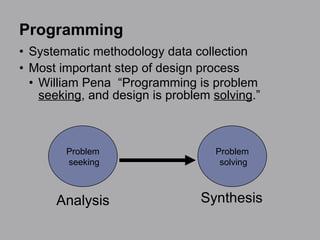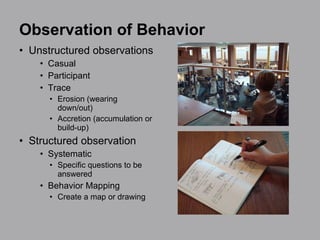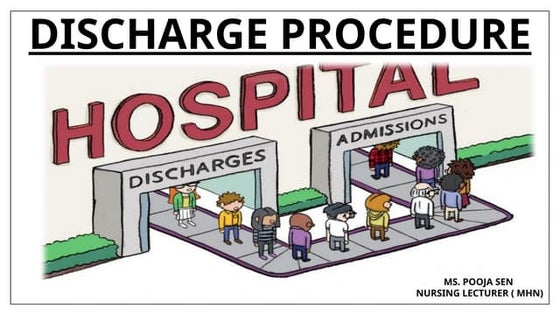Nussbaumer Ebd Sample
Download as PPT, PDF1 like528 views
The document discusses evidence-based design for interior designers. It outlines the design process as having systematic and logical problem solving methods including defining problems, research, generating alternatives, and implementing solutions. Research must be relevant to specific projects and is vital for effective design solutions. The programming process is described as the most important step, involving problem seeking and analysis to establish goals, gather facts, specify needs, and make decisions. Observation methods like unstructured observations and structured behavior mapping are also discussed.
1 of 11
Downloaded 11 times











Recommended
Management quality tools (6) 19 1-2016



Management quality tools (6) 19 1-2016Ahmed said
Ėý
This document describes several quality management and planning tools:
1. Affinity diagrams and mind mapping are used to organize large amounts of ideas or data into categories to understand problems and solutions.
2. Process decision program charts are a planning tool used to identify steps to complete a process and anticipate issues. They display the goals, steps, and timeline of implementing a plan like statistical process control.
3. Interrelationship digraphs identify and analyze cause-and-effect relationships between critical issues to find key drivers for effective solutions. They show multiple relationships rather than linear connections.Higgins becc nov 2010 evid based-design_final [compatibility mode]![Higgins becc nov 2010 evid based-design_final [compatibility mode]](https://cdn.slidesharecdn.com/ss_thumbnails/higginsbeccnov2010evid-baseddesignfinalcompatibilitymode-140103124627-phpapp02-thumbnail.jpg?width=560&fit=bounds)
![Higgins becc nov 2010 evid based-design_final [compatibility mode]](https://cdn.slidesharecdn.com/ss_thumbnails/higginsbeccnov2010evid-baseddesignfinalcompatibilitymode-140103124627-phpapp02-thumbnail.jpg?width=560&fit=bounds)
![Higgins becc nov 2010 evid based-design_final [compatibility mode]](https://cdn.slidesharecdn.com/ss_thumbnails/higginsbeccnov2010evid-baseddesignfinalcompatibilitymode-140103124627-phpapp02-thumbnail.jpg?width=560&fit=bounds)
![Higgins becc nov 2010 evid based-design_final [compatibility mode]](https://cdn.slidesharecdn.com/ss_thumbnails/higginsbeccnov2010evid-baseddesignfinalcompatibilitymode-140103124627-phpapp02-thumbnail.jpg?width=560&fit=bounds)
Higgins becc nov 2010 evid based-design_final [compatibility mode]Cathy_Higgins
Ėý
Feedback loops - bringing measured energy performance of commercial buildings to the designers, operators and tenants - can help current and future buildings meet design intent.
This presentation by Cathy Higgins, Research Director at New Buildings Institute, was given to the Behavior Energy and Climate Change Conference in Sacramento November 2010. Evidence-Based Design Thesis_PaulRamoie_2014



Evidence-Based Design Thesis_PaulRamoie_2014Paul Ramoie
Ėý
Evidence-based design is a process that uses research findings to inform design decisions with the goal of improving outcomes. It originated in healthcare to enhance patient and staff well-being and outcomes. Key aspects of EBD include collecting quantitative and qualitative research during programming to understand user needs, then applying findings throughout the design process. EBD has demonstrated benefits in healthcare like reducing infections through single-patient rooms, noise-reducing materials, and proper ventilation.Asu history and theory lecture 3a-programming 14-10-2017



Asu history and theory lecture 3a-programming 14-10-2017Galala University
Ėý
This document provides an overview of a lecture on architectural programming. It discusses programming as the first step of the project lifecycle where the goals and requirements are defined through research. This establishes the criteria to guide the design solution. The lecture notes then outline the programming framework, including preparing for programming through analyzing and synthesizing information at different scales. It also discusses common characteristics of programming formats such as defining goals and gathering/analyzing data. The goals of programming are to separate the definition of criteria from design and understand implications on costs.Asu history and theory lecture 3a-programming 14-10-2017



Asu history and theory lecture 3a-programming 14-10-2017Galala University
Ėý
This document provides an overview of a lecture on architectural programming. It discusses programming as the first step of the project lifecycle where the goals and requirements are defined through research. This establishes the criteria to guide the design solution. The lecture covers the programming framework including preparing for programming, analyzing and synthesizing information, and considering design factors like human, environmental, cultural and technical issues. Architectural programming is presented as the process of gathering, analyzing and documenting relevant information to define the problem to be solved by design.2012109 b cs_st_and_pm4



2012109 b cs_st_and_pm4Paul Summers
Ėý
Systems thinking views systems holistically rather than as separate parts. It examines the interconnections and interdependencies between system components. The document then discusses several schools of systems thinking and approaches to analyzing complex systems and organizations. It also summarizes common causes of project failure found in studies, such as lack of user input and changing requirements. Finally, it proposes a systemic approach to improve project performance through stakeholder engagement, rigorous planning and documentation, and organizational learning.Information Systems Action design research method



Information Systems Action design research methodRaimo Halinen
Ėý
This document outlines an agenda for a workshop on action design research methods. The workshop includes sessions on action design research, comparing design science, action research, and action design research methods, and using the action design research method. It discusses principles of action design research like problem-inspired research, theory-ingrained artifacts, and reciprocal shaping between researchers and practitioners. The document also includes frameworks and schemas for the generic action design research process.Architectural Design 1 Lectures by Dr. Yasser Mahgoub - Process



Architectural Design 1 Lectures by Dr. Yasser Mahgoub - ProcessGalala University
Ėý
The document discusses the architectural design process. It describes the typical phases as:
1) Pre-design phase which involves programming to understand user needs.
2) Site analysis to understand the site context and how it relates to the user needs.
3) Schematic design phase where the main concepts of form and space are generated to address the user needs within the site context.Design Synthesis.pptx



Design Synthesis.pptxseyefeselasse
Ėý
Design synthesis is the process of generating solutions based on insights from design analysis. It involves finding a leading concept or idea that summarizes all findings from collected information. Sources of data include literature reviews, case studies, and site analyses. The process involves collecting data from these sources, analyzing and interpreting the data, and deriving a concept or summary that represents the synthesis of all findings. Exercises are provided to help apply this process.Green Studio Handbook - Part 1



Green Studio Handbook - Part 1Galala University
Ėý
This chapter introduces the design process for green buildings and outlines the various stages from pre-design through construction and occupancy. It discusses defining the problem through establishing intent, criteria, and validation methods. Important considerations are collecting project data through site analysis and selection, allowing passive and active strategies to inform the building form, and using feedback loops to optimize performance. The overall process is iterative and integrates environmental strategies from the beginning.Introduction to Engineering Design



Introduction to Engineering DesignMANJUNATH N
Ėý
This document provides an introduction to engineering design. It begins by asking foundational questions about what engineering and engineering design are, and the differences between engineering analysis and design. Engineering design is defined as the process of devising a system to meet desired needs, and involves problem definition, research, conceptual design, evaluation and testing. The document outlines the typical steps in the engineering design process, including establishing objectives, generating concepts, analysis, testing prototypes, and improving the design. It also discusses types of designs, issues to consider like ethics and economics, and differences between engineering and other fields like science and art.Guc arct 702 legislations lecture 3 - design process and influences 5-10-2017



Guc arct 702 legislations lecture 3 - design process and influences 5-10-2017Galala University
Ėý
This document discusses the design process and influences on architectural design. It describes how the design process involves translating needs into appropriate buildings through analysis, synthesis and evaluation in both linear and non-linear ways. Key influences on design mentioned include the program, site conditions, building context, codes and regulations, sustainability, cost, schedule, technology and the client. The design process requires establishing goals, developing concepts, and evaluating alternatives while considering these various influences.Information Systems design science research



Information Systems design science researchRaimo Halinen
Ėý
The document discusses various aspects of developing and evaluating information systems using a design science research approach. It provides guidelines for conducting design science research, including that the research should design an artifact to solve an identified problem, evaluate the artifact and process, and ensure rigorous and communicable results. The document also discusses various process models and approaches for design science research.0708 Design Rationale (Introduction)



0708 Design Rationale (Introduction)Hans Kemp
Ėý
The document discusses the importance of design rationale for an iterative design process. It emphasizes that design is a collaborative effort that requires input from others. An explicit design rationale documents the design process, key decisions, and underlying reasons for those decisions based on research. This helps prevent locking into early decisions as requirements change and promotes a shared understanding of the design.Design process Phase1 by Dr. Prof Ehab Ezzat 



Design process Phase1 by Dr. Prof Ehab Ezzat Faculty of fine arts -Cairo. Egypt.
Ėý
The document outlines the steps of a design process including defining the problem, researching solutions, developing and testing designs, evaluating results, and finalizing the design. It also discusses gathering information, brainstorming ideas, conceptualizing space and functional zoning, developing solutions, and refining the design. The project involves designing areas for a consulting office including facilities, management, reception, and production areas.Ced unit 1 notes-new



Ced unit 1 notes-newDr.Yogesh Dewang
Ėý
This document provides an overview of concepts in engineering design taught by Dr. Yogesh Dewang. It discusses various topics including:
1. Designing a system by breaking it into subsystems and components in an iterative process.
2. Visualization by interpreting non-visual data and producing images.
3. Photography as a science, art, and practice of creating images.
4. Simplified iteration model showing design as an iterative process.
5. Comparison of engineering design method versus scientific method.Decision Sciences Management



Decision Sciences ManagementPiyush Vijay
Ėý
The document discusses quantitative analysis and decision making in management science, outlining the 7 steps of problem solving, uses of quantitative analysis, how to develop mathematical models, and providing an example of how management science could be used to model and solve a project scheduling problem to minimize completion time. Key aspects of models include objective functions, constraints, decision variables, and whether models are deterministic or stochastic.Effective Product Variant Management in Odoo 18



Effective Product Variant Management in Odoo 18Celine George
Ėý
In this slide weâll discuss on the effective product variant management in Odoo 18. Odoo concentrates on managing product variations and offers a distinct area for doing so. Product variants provide unique characteristics like size and color to single products, which can be managed at the product template level for all attributes and variants or at the variant level for individual variants.Meeting the needs of modern students?, Selina McCoy



Meeting the needs of modern students?, Selina McCoyEconomic and Social Research Institute
Ėý
NAPD Annual Symposium
âEquity in our Schools: Does the system deliver for all young people?âFunctional Muscle Testing of Facial Muscles.pdf



Functional Muscle Testing of Facial Muscles.pdfSamarHosni3
Ėý
Functional Muscle Testing of Facial Muscles.pdfHow to create security group category in Odoo 17



How to create security group category in Odoo 17Celine George
Ėý
This slide will represent the creation of security group category in odoo 17. Security groups are essential for managing user access and permissions across different modules. Creating a security group category helps to organize related user groups and streamline permission settings within a specific module or functionality.Administrative bodies( D and C Act, 1940



Administrative bodies( D and C Act, 1940P.N.DESHMUKH
Ėý
These presentation include information about administrative bodies such as D.T.A.B
CDL AND DCC, etc.Blind spots in AI and Formulation Science, IFPAC 2025.pdf



Blind spots in AI and Formulation Science, IFPAC 2025.pdfAjaz Hussain
Ėý
The intersection of AI and pharmaceutical formulation science highlights significant blind spotsâsystemic gaps in pharmaceutical development, regulatory oversight, quality assurance, and the ethical use of AIâthat could jeopardize patient safety and undermine public trust. To move forward effectively, we must address these normalized blind spots, which may arise from outdated assumptions, errors, gaps in previous knowledge, and biases in language or regulatory inertia. This is essential to ensure that AI and formulation science are developed as tools for patient-centered and ethical healthcare.How to Configure Recurring Revenue in Odoo 17 CRM



How to Configure Recurring Revenue in Odoo 17 CRMCeline George
Ėý
This slide will represent how to configure Recurring revenue. Recurring revenue are the income generated at a particular interval. Typically, the interval can be monthly, yearly, or we can customize the intervals for a product or service based on its subscription or contract. Intellectual Honesty & Research Integrity.pptx



Intellectual Honesty & Research Integrity.pptxNidhiSharma495177
Ėý
Research Publication & Ethics contains a chapter on Intellectual Honesty and Research Integrity.
Different case studies of intellectual dishonesty and integrity were discussed.More Related Content
Similar to Nussbaumer Ebd Sample (9)
Design Synthesis.pptx



Design Synthesis.pptxseyefeselasse
Ėý
Design synthesis is the process of generating solutions based on insights from design analysis. It involves finding a leading concept or idea that summarizes all findings from collected information. Sources of data include literature reviews, case studies, and site analyses. The process involves collecting data from these sources, analyzing and interpreting the data, and deriving a concept or summary that represents the synthesis of all findings. Exercises are provided to help apply this process.Green Studio Handbook - Part 1



Green Studio Handbook - Part 1Galala University
Ėý
This chapter introduces the design process for green buildings and outlines the various stages from pre-design through construction and occupancy. It discusses defining the problem through establishing intent, criteria, and validation methods. Important considerations are collecting project data through site analysis and selection, allowing passive and active strategies to inform the building form, and using feedback loops to optimize performance. The overall process is iterative and integrates environmental strategies from the beginning.Introduction to Engineering Design



Introduction to Engineering DesignMANJUNATH N
Ėý
This document provides an introduction to engineering design. It begins by asking foundational questions about what engineering and engineering design are, and the differences between engineering analysis and design. Engineering design is defined as the process of devising a system to meet desired needs, and involves problem definition, research, conceptual design, evaluation and testing. The document outlines the typical steps in the engineering design process, including establishing objectives, generating concepts, analysis, testing prototypes, and improving the design. It also discusses types of designs, issues to consider like ethics and economics, and differences between engineering and other fields like science and art.Guc arct 702 legislations lecture 3 - design process and influences 5-10-2017



Guc arct 702 legislations lecture 3 - design process and influences 5-10-2017Galala University
Ėý
This document discusses the design process and influences on architectural design. It describes how the design process involves translating needs into appropriate buildings through analysis, synthesis and evaluation in both linear and non-linear ways. Key influences on design mentioned include the program, site conditions, building context, codes and regulations, sustainability, cost, schedule, technology and the client. The design process requires establishing goals, developing concepts, and evaluating alternatives while considering these various influences.Information Systems design science research



Information Systems design science researchRaimo Halinen
Ėý
The document discusses various aspects of developing and evaluating information systems using a design science research approach. It provides guidelines for conducting design science research, including that the research should design an artifact to solve an identified problem, evaluate the artifact and process, and ensure rigorous and communicable results. The document also discusses various process models and approaches for design science research.0708 Design Rationale (Introduction)



0708 Design Rationale (Introduction)Hans Kemp
Ėý
The document discusses the importance of design rationale for an iterative design process. It emphasizes that design is a collaborative effort that requires input from others. An explicit design rationale documents the design process, key decisions, and underlying reasons for those decisions based on research. This helps prevent locking into early decisions as requirements change and promotes a shared understanding of the design.Design process Phase1 by Dr. Prof Ehab Ezzat 



Design process Phase1 by Dr. Prof Ehab Ezzat Faculty of fine arts -Cairo. Egypt.
Ėý
The document outlines the steps of a design process including defining the problem, researching solutions, developing and testing designs, evaluating results, and finalizing the design. It also discusses gathering information, brainstorming ideas, conceptualizing space and functional zoning, developing solutions, and refining the design. The project involves designing areas for a consulting office including facilities, management, reception, and production areas.Ced unit 1 notes-new



Ced unit 1 notes-newDr.Yogesh Dewang
Ėý
This document provides an overview of concepts in engineering design taught by Dr. Yogesh Dewang. It discusses various topics including:
1. Designing a system by breaking it into subsystems and components in an iterative process.
2. Visualization by interpreting non-visual data and producing images.
3. Photography as a science, art, and practice of creating images.
4. Simplified iteration model showing design as an iterative process.
5. Comparison of engineering design method versus scientific method.Decision Sciences Management



Decision Sciences ManagementPiyush Vijay
Ėý
The document discusses quantitative analysis and decision making in management science, outlining the 7 steps of problem solving, uses of quantitative analysis, how to develop mathematical models, and providing an example of how management science could be used to model and solve a project scheduling problem to minimize completion time. Key aspects of models include objective functions, constraints, decision variables, and whether models are deterministic or stochastic.Recently uploaded (20)
Effective Product Variant Management in Odoo 18



Effective Product Variant Management in Odoo 18Celine George
Ėý
In this slide weâll discuss on the effective product variant management in Odoo 18. Odoo concentrates on managing product variations and offers a distinct area for doing so. Product variants provide unique characteristics like size and color to single products, which can be managed at the product template level for all attributes and variants or at the variant level for individual variants.Meeting the needs of modern students?, Selina McCoy



Meeting the needs of modern students?, Selina McCoyEconomic and Social Research Institute
Ėý
NAPD Annual Symposium
âEquity in our Schools: Does the system deliver for all young people?âFunctional Muscle Testing of Facial Muscles.pdf



Functional Muscle Testing of Facial Muscles.pdfSamarHosni3
Ėý
Functional Muscle Testing of Facial Muscles.pdfHow to create security group category in Odoo 17



How to create security group category in Odoo 17Celine George
Ėý
This slide will represent the creation of security group category in odoo 17. Security groups are essential for managing user access and permissions across different modules. Creating a security group category helps to organize related user groups and streamline permission settings within a specific module or functionality.Administrative bodies( D and C Act, 1940



Administrative bodies( D and C Act, 1940P.N.DESHMUKH
Ėý
These presentation include information about administrative bodies such as D.T.A.B
CDL AND DCC, etc.Blind spots in AI and Formulation Science, IFPAC 2025.pdf



Blind spots in AI and Formulation Science, IFPAC 2025.pdfAjaz Hussain
Ėý
The intersection of AI and pharmaceutical formulation science highlights significant blind spotsâsystemic gaps in pharmaceutical development, regulatory oversight, quality assurance, and the ethical use of AIâthat could jeopardize patient safety and undermine public trust. To move forward effectively, we must address these normalized blind spots, which may arise from outdated assumptions, errors, gaps in previous knowledge, and biases in language or regulatory inertia. This is essential to ensure that AI and formulation science are developed as tools for patient-centered and ethical healthcare.How to Configure Recurring Revenue in Odoo 17 CRM



How to Configure Recurring Revenue in Odoo 17 CRMCeline George
Ėý
This slide will represent how to configure Recurring revenue. Recurring revenue are the income generated at a particular interval. Typically, the interval can be monthly, yearly, or we can customize the intervals for a product or service based on its subscription or contract. Intellectual Honesty & Research Integrity.pptx



Intellectual Honesty & Research Integrity.pptxNidhiSharma495177
Ėý
Research Publication & Ethics contains a chapter on Intellectual Honesty and Research Integrity.
Different case studies of intellectual dishonesty and integrity were discussed.Dot NET Core Interview Questions PDF By ScholarHat



Dot NET Core Interview Questions PDF By ScholarHatScholarhat
Ėý
Dot NET Core Interview Questions PDF By ScholarHatInterim Guidelines for PMES-DM-17-2025-PPT.pptx



Interim Guidelines for PMES-DM-17-2025-PPT.pptxsirjeromemanansala
Ėý
This is the latest issuance on PMES as replacement of RPMS. Kindly message me to gain full access of the presentation. NUTRITIONAL ASSESSMENT AND EDUCATION - 5TH SEM.pdf



NUTRITIONAL ASSESSMENT AND EDUCATION - 5TH SEM.pdfDolisha Warbi
Ėý
NUTRITIONAL ASSESSMENT AND EDUCATION, Introduction, definition, types - macronutrient and micronutrient, food pyramid, meal planning, nutritional assessment of individual, family and community by using appropriate method, nutrition education, nutritional rehabilitation, nutritional deficiency disorder, law/policies regarding nutrition in India, food hygiene, food fortification, food handling and storage, food preservation, food preparation, food purchase, food consumption, food borne diseases, food poisoningDr. Ansari Khurshid Ahmed- Factors affecting Validity of a Test.pptx



Dr. Ansari Khurshid Ahmed- Factors affecting Validity of a Test.pptxKhurshid Ahmed Ansari
Ėý
Validity is an important characteristic of a test. A test having low validity is of little use. Validity is the accuracy with which a test measures whatever it is supposed to measure. Validity can be low, moderate or high. There are many factors which affect the validity of a test. If these factors are controlled, then the validity of the test can be maintained to a high level. In the power point presentation, factors affecting validity are discussed with the help of concrete examples.Inventory Reporting in Odoo 17 - Odoo 17 Inventory App



Inventory Reporting in Odoo 17 - Odoo 17 Inventory AppCeline George
Ėý
This slide will helps us to efficiently create detailed reports of different records defined in its modules, both analytical and quantitative, with Odoo 17 ERP.Nussbaumer Ebd Sample
- 1. Evidence Based Design for Interior Designers Linda Nussbaumer
- 2. Design Process Systematic, logical method of solving design problem Creative problem solving Defining the problem Collecting, analyzing, and synthesizing data Generating and evaluating alternatives Implementing solutions Design solution is only as good as the quality of its research Research must be relevant to a particular project Research is vital to implement design solution
- 3. Design Process Table 1.1
- 4. Programming Systematic methodology data collection Most important step of design process William Pena âProgramming is problem seeking , and design is problem solving .â Problem seeking Problem solving Analysis Synthesis
- 5. Steps in Programming Establish goals Gather and analyze facts Specify needs Evaluate Organize and decide Present conclusions Continuous Feedback Table 1.2
- 6. Observation of Behavior Unstructured observations Casual Participant Trace Erosion (wearing down/out) Accretion (accumulation or build-up) Structured observation Systematic Specific questions to be answered Behavior Mapping Create a map or drawing
- 7. Site Analysis A graphical analysis of the sunâs orientation Figure 6.1
- 8. Key Terms concrete masonry unit (CMU) geodesic dome renovation or rehabilitation site planning universal design zoning zoning districts zoning law
- 9. Historic Precedents Jefferson studied Roman architecture
- 10. Historic Precedents Application of criteria Questions to ask Use Table 4.1-4 along with Table 4.2.1 Analysis Criteria Historic precedents Applied to design project Architectural/ Kimbell Art Museum Hypothetical Interior Theoretical Kimbell Art Museum Hypothetical Table 4.1-4 and 4.2.1
- 11. Paris Registration waiting area Figure Case Study 13.2






